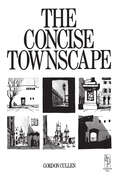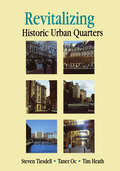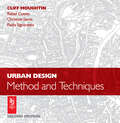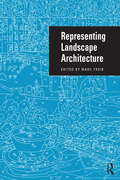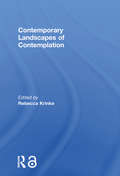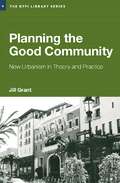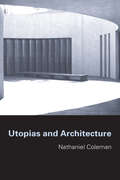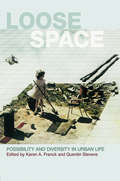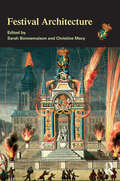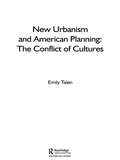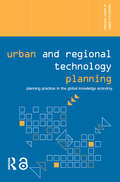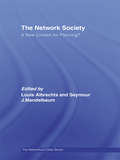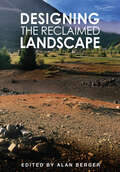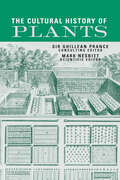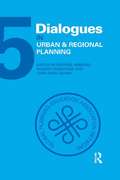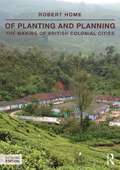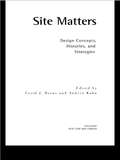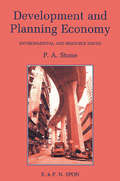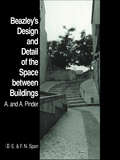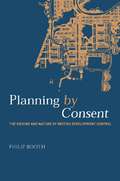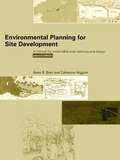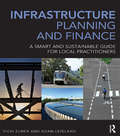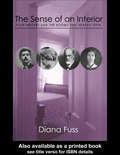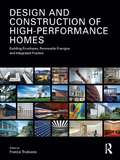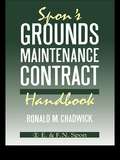- Table View
- List View
Concise Townscape
by Gordon CullenThis book pioneered the concept of townscape. 'Townscape' is the art of giving visual coherence and organization to the jumble of buildings, streets and space that make up the urban environment. It has been a major influence on architects, planners and others concerned with what cities should look like.
Revitalising Historic Urban Quarters
by Steve Tiesdell Tim Heath Taner OcThis book synthesizes urban design and urban regeneration by examining the revitalization of a number of historic urban quarters. Its focus is on quarters or areas where there is a significant number of historic buildings concentrated in a small area; with places and area-based approaches. Many cities have such quarters that confer on them a sense of place and identity through their historic continuity and cultural associations. The quarters are often an integral element of the city's image and identity. The lessons and observations from the experience of the revitalization of such historic urban quarters forms the core ofthis book with a number of case study examples from North America and Europe showing a variety of approaches to and outcomes of revitalization.
Urban Design: Method And Techniques
by Paola Signoretta Rafael Cuesta Christine Sarris J.C MoughtinThis book deals with a wide range of techniques used in the urban design process. It then goes on to relate these techniques to a unique, comprehensive account of method. A method of urban design is developed which has sustainability and environmental protection at the centre of its philosophy. Previously, literature regarding the urban design method has been almost totally neglected; this book introduces the topic to the reader. This revised Second Edition encompasses the latest techniques including the development of geographic information systems and financial techniques which help evaluate projects.A number of techniques are illustrated by example or case study. Where techniques are discussed they are located within the structure of the design process. The book develops a logical framework for a process, which includes problem definition, survey, analysis, concept generation, evaluation and implementation. It is this framework which leads toward the development of an urban design method. This book is a practical guide for students or professionals in the early part of their careers. It is organized so that each chapter provides guidance which readers would have otherwise had to discover for themselves, often with some difficulty.
Representing Landscape Architecture
by Marc TreibRepresenting Landscape Architecture offers a broad investigation of how the designed landscape is and has been represented: for design study, for criticism and even for its realization. It has been said that we can only realize what we can imagine. But in order to realize we must convey ideas to others as well as to ourselves. Representation is by no means neutral and the process of communication, the process by which the imagination takes its first form, itself necessarily limits the range of our design possibilities. Computers further remove from cognitive processes and raise new questions about methods and limits. Written by a team of renowned practitioners and academics, this book is the best available reference to date on the many dimensions of landscape representation.
Contemporary Landscapes of Contemplation
by Rebecca KrinkeContemplative landscape and contemplative space are familiar terms in the areas of design, landscape architecture and architecture. Krinke and her highly regarded contributors set out to explore definitions, theories, and case studies of contemplative landscapes. The contributors, Marc Treib, John Beardsley, Michael Singer, Lance Neckar, Heinrich Hermann and Rebecca Krinke have spent their careers researching, critiquing, and making landscapes. Here they investigate the role of contemplative space in a post-modern world and examine the impact of nature and culture on the design or interpretation of contemplative landscapes. The essays, drawn from both scholarship and personal experience explore the links between spaces designed to provide health benefits and contemplative space.
Planning the Good Community: New Urbanism in Theory and Practice (RTPI Library Series)
by Jill GrantAn examination of new urban approaches both in theory and in practice. Taking a critical look at how new urbanism has lived up to its ideals, the author asks whether new urban approaches offer a viable path to creating good communities. With examples drawn principally from North America, Europe and Japan, Planning the Good Community explores new urban approaches in a wide range of settings. It compares the movement for urban renaissance in Europe with the New Urbanism of the United States and Canada, and asks whether the concerns that drive today’s planning theory – issues like power, democracy, spatial patterns and globalisation- receive adequate attention in new urban approaches. The issue of aesthetics is also raised, as the author questions whether communities must be more than just attractive in order to be good. With the benefit of twenty years’ hindsight and a world-wide perspective, this book offers the reader unparalleled insight as well as a rigorous and considered critical analysis.
Utopias and Architecture: Reconsidering Architecture And Utopia (Ralahine Utopian Studies #8)
by Nathaniel ColemanUtopian thought, though commonly characterized as projecting a future without a past, depends on golden models for re-invention of what is. Through a detailed and innovative re-assessment of the work of three architects who sought to represent a utopian content in their work, and a consideration of the thoughts of a range of leading writers, Coleman offers the reader a unique perspective of idealism in architectural design. With unparalleled depth and focus of vision on the work of Le Corbusier, Louis I Kahn and Aldo van Eyck, this book persuasively challenges predominant assumptions in current architectural discourse, forging a new approach to the invention of welcoming built environments and transcending the limitations of both the postmodern and hyper-modern stance and orthodox modernist architecture.
Loose Space: Possibility and Diversity in Urban Life
by Karen A. Franck Quentin StevensIn cities around the world people use a variety of public spaces to relax, to protest, to buy and sell, to experiment and to celebrate. Loose Space explores the many ways that urban residents, with creativity and determination, appropriate public space to meet their own needs and desires. Familiar or unexpected, spontaneous or planned, momentary or long-lasting, the activities that make urban space loose continue to give cities life and vitality. The book examines physical spaces and how people use them. Contributors discuss a wide range of recreational, commercial and political activities; some are conventional, others are more experimental. Some of the activities occur alongside the intended uses of planned public spaces, such as sidewalks and plazas; other activities replace former uses, as in abandoned warehouses and industrial sites. The thirteen case studies, international in scope, demonstrate the continuing richness of urban public life that is created and sustained by urbanites themselves Presents a fresh way of looking at urban public space, focusing on its positive uses and aspects. Comprises 13 detailed, well-illustrated case studies based on sustained observation and research by social scientists, architects and urban designers. Looks at a range of activities, both everyday occurrences and more unusual uses, in a variety of public spaces -- planned, leftover and abandoned. Explores the spatial and the behavioral; considers the wider historical and social context. Addresses issues of urban research, architecture, urban design and planning. Takes a broad international perspective with cases from New York, London, Berlin, Amsterdam, Rome, Guadalajara, Athens, Tel Aviv, Melbourne, Bangkok, Kandy, Buffalo, and the North of England.
Festival Architecture (The Classical Tradition in Architecture)
by Sarah Bonnemaison Christine MacyWith contributions from provocative art and architectural historians, this book is a unique exposition of the temporary architecture erected for festivals and the role it has played in developing Western architectural and urban theory. Festival Architecture is arranged in historical periods – from Antiquity to the modern era – and divided between analyses of specific festivals, set in relation to contemporary architecture and urban design ideas and theories. Illustrated with a wealth of unusual and rarely-seen images from the European festival tradition, this is a fascinating outline of the history of festival architecture ideal for postgraduate architecture and urban design students.
New Urbanism and American Planning: The Conflict of Cultures (Planning, History and Environment Series)
by Emily TalenNew Urbanism and American Planning presents the history of American planners’ quest for good cities and shows how New Urbanism is a culmination of ideas that have been evolving since the nineteenth century. In her survey of the last hundred or so years of urbanist ideals, Emily Talen identifies four approaches to city-making, which she terms ‘cultures’: incrementalism, plan-making, planned communities, and regionalism. She shows how these cultures connect, overlap, and conflict and how most of the ideas about building better settlements are recurrent. In the first part of the book Talen sets her theoretical framework and in the second part provides detailed analysis of her four ‘cultures’.She concludes with an assessment of the successes and failures of the four cultures and the need to integrate these ideas as a means to promoting good urbanism in America.
Urban and Regional Technology Planning: Planning Practice in the Global Knowledge Economy (Networked Cities Series)
by Kenneth E. Corey Mark WilsonPart of the popular Networked Cities series, Urban and Regional Technology Planning focuses on the practice of relational planning and the stimulation of local city-regional scale development planning in the context of the global knowledge economy and network society. Designed to offer scholars, practitioners, and decision makers studies on the ways of cities, technologies, and multiple forms of urban movement intersect and create the contemporary urban environment, Kenneth Corey and Mark Wilson explore the dynamics of technology-induced change that is taking place within the context of the global knowledge economy and network society. Examining first the knowledge economy itself, Wilson and Corey go on to discuss its implications before proposing ways to strategize for future intelligent development, with particular emphasis on the ALERT model for regional and local planning. An important read for those practicing or studying planning in this network society.
The Network Society: A New Context for Planning (Networked Cities Series)
by Louis Albrechts Seymour J. MandelbaumIn a clear and rewarding style, Albrechts and Mandelbaum consider the challenges that the new paradigm of the Network Society creates for Urban and Regional Planning. Chapters grouped into five themes discuss theoretical and practical perspectives on the contemporary organization of social, economic, cultural, political and physical spaces. These sections are: models of the Network Society the impact of physical networks such as transport challenges for Planners raised by society’s increased reliance on new technology an examination of local networks including community networks and the possibilities of setting up local networks for disaster recovery a comparison of spatial and policy networks and an exploration of the institutions involved. This book is essential reading for graduate level courses in urban studies, city and regional planning, and urban design. With its clear structure – unitary sections but a diversity of perspectives – the book can be used easily in courses such as Planning Theory, Urban Infrastructure and Public Policy.
Designing the Reclaimed Landscape
by Alan BergerThe first practical yet in-depth exploration of how to reclaim the post-industrial landscape, this volume includes excellent case studies by practitioners and policy makers from around the US, giving first rate practical examples. The book addresses new thinking about landscape, which applies new techniques to the task of transforming outdated and disused post-extraction landscapes through design. In the USA alone, there are nearly 500,000 abandoned mines in need of reclamation and this book provides the first in-depth guidance on this real and pressing issue. Drawing on the work of the well-known Project for Reclamation Excellence at Harvard's Graduate School of Design, this volume outlines the latest design thinking, theory and practice for landscape planners, landscape architects and designers and others interested in maximizing the future potential of reclaimed land.
The Cultural History of Plants
by Mark Nesbitt Ghillean PranceThis valuable reference will be useful for both scholars and general readers. It is both botanical and cultural, describing the role of plant in social life, regional customs, the arts, natural and covers all aspects of plant cultivation and migration and covers all aspects of plant cultivation and migration. The text includes an explanation of plant names and a list of general references on the history of useful plants.
Dialogues in Urban and Regional Planning: Volume 5
by Michael Hibbard Robert Freestone Tore Øivin SagerDialogues in Urban and Regional Planning 5 is a selection of some of the best scholarship in urban and regional planning from around the world. The internationally recognized authors of these award-winning papers take up a range of salient issues from the theory and practice of planning. The topics they address include the effects of globalization on world cities, metropolitan planning in France and Australia, and new research in pedestrian and traffic design. The breadth of the topics covered in this book will appeal to all those with an interest in urban and regional planning, providing a springboard for further debate and research. The papers focus particularly on themes of inclusion, urban transformation, metropolitan planning, and urban design. The Dialogues in Urban and Regional Planning (DURP) book series is published in association with the Global Planning Education Association Network (GPEAN) and its member national and transnational planning schools associations.
Of Planting and Planning: The making of British colonial cities (Planning, History and Environment Series)
by Robert Home‘At the centre of the world-economy, one always finds an exceptional state, strong, aggressive and privileged, dynamic, simultaneously feared and admired.’ - Fernand Braudel, Civilization and Capitalism, 15th–18th Centuries This, surely, is an apt description of the British Empire at its zenith. Of Planting and Planning explores how Britain used the formation of towns and cities as an instrument of colonial expansion and control throughout the Empire. Beginning with the seventeenth-century plantation of Ulster and ending with decolonization after the Second World War, Robert Home reveals how the British Empire gave rise to many of the biggest cities in the world and how colonial policy and planning had a profound impact on the form and functioning of those cities. This second edition retains the thematic, chronological and interdisciplinary approach of the first, each chapter identifying a key element of colonial town planning. New material and illustrations have been added, incorporating the author's further research since the first edition. Most importantly, Of Planting and Planning remains the only book to cover the whole sweep of British colonial urbanism.
Site Matters: Design Concepts, Histories and Strategies
by Carol J Burns Andrea KahnOne of the trends in twentieth century architecture and planning has been to denigrate and ignore the site, or larger context (both physical and social), surrounding a building or set of buildings. Focussing on Le Corbusier's designs, Site Matters presents that first considered theory and vocabulary for the inevitable reaction against Modernism in planning, beginning in the 1960s and swelling through the 1980s as architects and planners alike developed a new appreciation of site, reincorporating the wider context into their plans. Theoretical essays and empirically grounded pieces combine to provide the language and theory of this re-emergence of site, looking at Le Corbusier's designs, contemporary suburbs, and the planning agendas involved at the World Trade Center site. Groundbreaking and innovative, Site Matters provides valuable theory and vocabulary for planners and architects.
Development and Planning Economy: Environmental and resource issues
by P.A. StoneThis book describes in detail how the property market operates, giving a clear picture of the economics of development and the way which development issues are defined by (and in their turn have an effect on) community and individual needs. By describing how the market works and explaining the factors which need to be analysed, the author aims to improve decision-making techniques and machinery.
Beazley's Design and Detail of the Space between Buildings
by A. PinderA new edition of a book widely regarded as a classic of landscape architecture, it deals with the 'bits' that go in between the different parts of the urban landscape. A completely updated text makes it suitable for both the professional and student.
Planning by Consent: The Origins and Nature of British Development Control (Planning, History and Environment Series)
by Philip Booth**Please note this is an unedited paperback reprint of the hardback, originally published in 2003** The British system of universal development control celebrated its 50th anniversary in 1997. Remarkably, the system has survived more or less intact but the experience of the 1980s has left large questions unanswered about the relevance and effectiveness of the system. This book traces the history of the development control system in Britain from early modern times to the present day.
Environmental Planning for Site Development: A Manual for Sustainable Local Planning and Design
by Anne Beer Cathy HigginsEnvironmental planning forms the basis of all site development decisions and deals with the factors that must be considered before a site plan can be drawn up. Environmental Planning for Site Development emphasizes the man/nature interface and explains how nature limits and controls what can happen on every piece of land. The text is clearly set out and will help the reader understand exactly what information is needed for a site planning proposal. The book includes a live case study to demonstrate how GIS systems are now assisting in the design and decision process as communities increasingly participate in local decisions. (Local Agenda 21)
Infrastructure Planning and Finance: A Smart and Sustainable Guide
by Vicki Elmer Adam LeiglandInfrastructure Planning and Finance is a non-technical guide to the engineering, planning, and financing of major infrastucture projects in the United States, providing both step-by-step guidance, and a broad overview of the technical, political, and economic challenges of creating lasting infrastructure in the 21st Century. Infrastructure Planning and Finance is designed for the local practitioner or student who wants to learn the basics of how to develop an infrastructure plan, a program, or an individual infrastructure project. A team of authors with experience in public works, planning, and city government explain the history and economic environment of infrastructure and capital planning, addressing common tools like the comprehensive plan, sustainability plans, and local regulations. The book guides readers through the preparation and development of comprehensive plans and infrastructure projects, and through major funding mechanisms, from bonds, user fees, and impact fees to privatization and competition. The rest of the book describes the individual infrastructure systems: their elements, current issues and a 'how-to-do-it' section that covers the system and the comprehensive plan, development regulations and how it can be financed. Innovations such as decentralization, green and blue-green technologies are described as well as local policy actions to achieve a more sustainable city are also addressed. Chapters include water, wastewater, solid waste, streets, transportation, airports, ports, community facilities, parks, schools, energy and telecommunications. Attention is given to how local policies can ensure a sustainable and climate friendly infrastructure system, and how planning for them can be integrated across disciplines.
The Sense of an Interior: Four Rooms and the Writers that Shaped Them
by Diana FussThe Sense of an Interior is a fascinating exploration of domestic space and of the ways it determines how writers work. The book looks at four famous figures - Emily Dickinson, Sigmund Freud, Helen Keller, and Marcel Proust, and examines the relationship between their work and the spaces where they wrote.
Design and Construction of High-Performance Homes: Building Envelopes, Renewable Energies and Integrated Practice
by Franca TrubianoBoth professionals and students are increasingly committed to achieving high-performance metrics in the design, construction and operation of residential buildings. This book responds to this demand by offering a comprehensive guide which features: architectural innovations in building skin technologies which make lighter more transparent buildings high performing; energy-free architectural design principles and advances in building-integrated photovoltaics; essential engineering principles, controls and approaches to simulation for achieving net zero; the advantages of integrated design in residential construction and the challenges and opportunities it engenders; detailed case studies of innovative homes which have incorporated low-energy design solutions, new materials, alternative building assemblies, digital fabrication, integrated engineering systems and operational controls. Divided into four parts, the book discusses the requisite AEC (Architecture, Engineering and Construction) knowledge needed when building a high-performance home. It also communicates this information across four case studies, which provide the reader with a thorough overview of all aspects to be considered in the design and construction of sustainable homes. With contributions from experts in the field, the book provides a well-rounded and multi-faceted approach. This book is essential reading for students and professionals in design, architecture, engineering (civil, mechanical and electrical), construction and energy management.
Spon's Grounds Maintenance Contract Handbook
by Mr R Chadwick R.M. ChadwickAimed at those at the sharp end of contract grounds maintenance, this book will provide guidance for anyone unfamiliar with the process of contracting work out. Written in a clear and readable style and full of practical details it will be particularly valuable to local authorities who, from 1990 will be thrown into contractual maintenance and competitive tendering for the first time.
